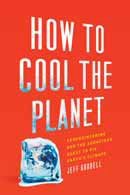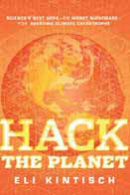SEJournal Online is the digital news magazine of the Society of Environmental Journalists. Learn more about SEJournal Online, including submission, subscription and advertising information.
 |
BookShelf
How to Cool the Planet: Geoengineering and the Audacious Quest to Fix Earth’s Climate
By Jeff Goodell
Houghton Mifflin Harcourt, 2010
AND
 |
Hack the Planet: Science’s Best Hope — Or Worst Nightmare — for Averting Climate Catastrophe
By Eli Kintisch
John Wiley & Sons, 2010
Reviewed by SUSAN MORAN
Geoengineering is either the worst idea for the planet since the invention of ozone-eating chlorofluorocarbons or it is the globe’s salvation. Perhaps it’s a bit of both.
Without question, it is a bold, audacious concept to amend for our profligate hydrocarbon fuels consumption by reining in climate change. That’s the upside, so what’s the downside? The downside is that geoengineering, a catchall term for a suite of unproven technologies, may treat the symptoms and do nothing about the root cause of climate change. Depending on the fix,ocean acidification could continue, wreaking havoc on biota critical to life on the planet. Furthermore, a technical fix could unleash new, unintended climatic consequences for some parts of the world.
Geoengineering proposals fall into two categories: long-wave approaches and short-wave approaches. Long-wave approaches would draw carbon dioxide out of the atmosphere to arrest the pace of warming. They involve either high-tech scrubbing methods or enhanced natural processes, such as carbon sequestration in the oceans and in forests. Short-wave methods would make the planet look whiter so it reflects more visible (i.e., shortwave) sunlight back into space before the light gets turned into heat. They could include massive projects that shoot sulphate particles into the stratosphere from high-altitude aircraft or from boats. These projects sound ambitious and expensive, but by some estimates, they could be a less expensive way to combat global warming than using carbon-trading markets.
This year, several books have emerged that help make sense of the geoengineering options undergoing serious research. The first two books simultaneously appeared on the shelves this spring. How To Cool the Planet: Geoengineering and the Audacious Quest to Fix Earth’s Climate, by Jeff Goodell, a contributing editor for Rolling Stone, and Hack the Planet: Science’s Best Hope — Or Worst Nightmare — For Averting Climate Catastrophe by Eli Kintisch, a reporter for the journal Science. Other books that have not been reviewed yet in SEJournal are Fixing the Sky: The Checkered History of Weather and Climate Control, by James Rodger Fleming, a professor of science, technology and society at Colby College, and Coming Climate Crisis? Consider the Past, Beware the Big Fix, by Claire L. Parkinson, a NASA scientist. Yet another book, The Climate Fix, by Roger Pielke Jr., a professor of environmental studies at the University of Colorado, Boulder, is waiting in the wings with a fall publication date.
How do Goodell’s and Kintisch’s books compare? Goodell’s book benefits from storytelling, colorful characters and a coherent narrative. For those who want a more detailed description of the science and engineering involved in the various “hack the planet” attempts, Kintisch delivers. Yet their underlying message is the same. Neither Goodell nor Kintisch are geoengineering evangelists. Both stress that in the ideal world we would solve the climate crisis through energy conservation, renewable energy and mandatory emissions reductions. But, they say, given the accelerating rate of climate change, we can’t afford not to put research money and brains into a possible Plan B.
So what does this alleged Plan B look like? All answers are little more than rough blueprints so far, with no proof of concept beyond small experiments. One short-wave method that may hold the most bang for the buck involves reflecting sunlight — solar radiation — back into the atmosphere. Imagine a giant hose that sprays sulfate aerosols into the sky, a process that essentially mimics a volcano and could reduce average global temperatures for a low sticker price. The second method involves pulling carbon from the atmosphere and sequestering it in the oceans or in buried geological formations. The potentially largest-scale approach here is fertilizing the oceans with iron (a micro-nutrient in short supply) to spur blooms of phytoplankton, which soak up carbon and deliver it to the ocean floor when they die. As Goodell says, “It’s like pouring Miracle-Gro on your garden.”
Both technologies could have dangerous side effects. The impact on ocean life from iron fertilization, for instance, is uncertain. And it is unclear how much of the carbon temporarily captured in the plant biomass would actually be mineralized. Scientists such as Sallie Chrisholm, an MIT ecologist, caution that marine sequestration could drastically alter ocean chemistry and the ocean food chain.
Beyond the potentially dire ecological costs of geoengineering, any global-scale project, even if it worked, could send whole regions and cultures into a tailspin. Global climate is a complex system. Rain patterns can shift as dramatically as temperature, for example. Would there be some mechanism to compensate African farmers in the Sahel, if temperatures cool but rain no longer irrigates their crops? And both authors ask who would — or should — control any geoengineering deployment. Given the lack of existing international treaties or laws regulating its use, the potential for geopolitical conflict and inequity is huge.
Goodell — a child of the Silicon Valley and a father of three — writes in his book that he found himself fearing that nothing short of an audacious techno-fix could solve global warming. He eloquently sums up the precarious ethical juncture of the prospect of altering the planet: “I do believe this is what it comes down to. We can use our imagination and ingenuity to create something beautiful and sustainable, or we can destroy ourselves with stupidity and greed. It is our choice.”
Susan Moran is a freelance journalist based in Boulder, Colo.
* From the quarterly newsletter SEJournal, Winter 2010-11 issue.












 Advertisement
Advertisement 



